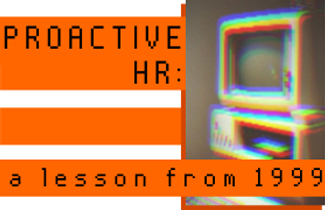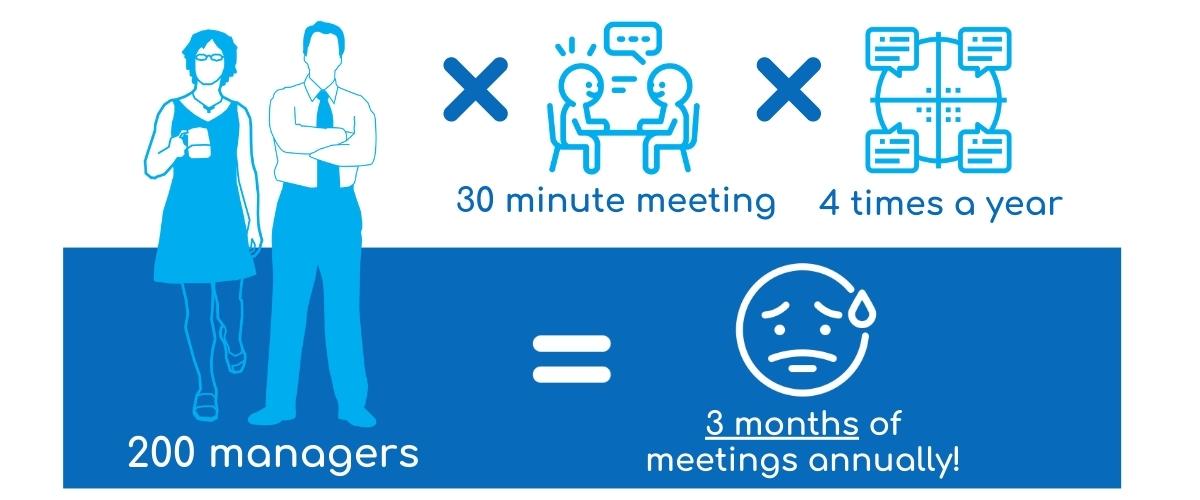
Create a Proactive HR Function
Create a Proactive HR Function
February 07, 2023
The value of creating a proactive HR delivery machine is obvious. This quick read (5 mins) gives ideas about what can be achieved and why as a HR Leader you should invest some thought to this topic!
A lesson from 1999
As a HR Leader, what price would you put on being able to:
- See the people gaps coming up in your business early, allowing your team the opportunity to devise realistic “grow or buy” strategies?
- Know about potential performance issues sooner, and be able to manage better business outcomes?
- Work to reduce the threat of flight risks in key roles?
- Deploy internal talent into stretching roles at the opportune time to maximise value and engagement?
- Understand succession information at every level within your business?
- Increase working capacity across your business, ensuring that more teams are full and delivering output for more of the time?
You already have the tools and resources available to you to achieve the above, after all – it isn’t rocket science…
- Teams could already be full, more often if your Talent and Recruitment teams could fill positions when a manager needs them filling, not weeks/months later.
- HR/Talent Partners could easily plan suitable moves for key internal talent if they knew what positions will be available in the business, and when.
- It would become obvious where to focus your team’s attention around skills development vs. skills acquisition if you all knew what skills are going to be needed, and when.
- Flight risks could be reduced dramatically when key individuals could be targeted for internal moves and stretch assignments early (i.e. before their engagement drops off a cliff).
- Your Employee Relations / HRBP teams can already guide managers on how to proactively deal with performance concerns, if they know where to focus their attention…
So why aren’t your teams doing all of this already, all the time?
Simple – you have lost the power of proactivity. It was quietly taken from you when the centralised HR model came to town.
Think about it. You probably used to work in a HR model that had far more “embedded” HR professionals within the business. They were available to see and speak to operational managers at a moment’s notice.
They were available and (actively) invited to operational meetings. Listening, learning, and storing information about people risks and priorities.
They were having conversations in corridors and kitchens, gleaning extremely useful information.
They were available for managers to “drop in on” to discuss anything on their mind.
They were the proactive generation of HR! They just never realised it at the time.
You may think that a centralized model is the only way to structure a HR function in the 21st Century, and you may be right. It brings a lot – economy of scale, lower costs, consistent approaches to key people tasks…
But you also sacrifice a lot to have it.
Before centralisation, HR colleagues had their finger on the pulse. They knew everyone and everything that was happening in their business. Who was performing (and who wasn’t), who was leaving, who was joining, even who was looking to leave. Who the good managers were, and who needed more support and guidance…
Imagine if you could have that level of insight across your business today.
If you did you could build a function that delivered a very different perception of quality from your business stakeholders.
People are the beating heart of any organisation. Being able to drive and maintain better engagement, retention and capability would mean HR were directly driving business success.
Unquestionably.
As already noted, you have the tools and resources to do this today. What you don’t have is the right communication link into your business. Into every corner of your business, to understand what is happening. Just like those “old fashioned” HR folk from the past.
Without this communication you have nothing. Your team will always be chasing their tails. Putting out fires and feeling guilty that they have the word “strategic” in their job descriptions.
The frustrating thing is that the communication link is perhaps the easiest piece of the puzzle to fix.
Your team just need to speak to your operational line managers and find out what is happening in their teams. Then check back every few months to get an update.
So, it is merely a case of speaking to every line manager, every few months, without fail. Then use the learnings to support, guide and drive their management activity to ensure your workforce are getting the best opportunity to be their “best”.
Easy in principle. Difficult at scale.
Take an example of a 2000 headcount business, with roughly 10% line managers. That would be 200 line managers to speak to. Every 3 months. Half an hour per meeting = 100 hours of meetings every 3 months. Plus, some scheduling time.
That means 3 weeks out of 3 months and your team haven’t “done” anything yet.

Maybe we’re starting to see why great communication and centralised HR don’t mix too well. There just isn’t the man/woman power anymore. Hang on a second though, we use self-service within our model and expect our line managers to come to us when they need us.
Problem Solved...Or Is It?
If you can say with a straight face that your manager community uses self-serve to inform HR about all their people needs, at the most opportune time, then hat tip to you!
The reality is that self-serve doesn’t work as we’d all hope. And we need to have a quick think about human behaviour to answer the obvious “why”?
People like easy. People are like water; in that they choose the path of least resistance!
So, whilst you may well have a shiny HRIS with full “self-serve” capability, what your friendly HRIS Account Manager won’t tell you is that they are desperately working on ways to improve the compliance rates of managers actually self-serving!
A manager in your business is a busy person just doing their day job. What is it do you think that gives them a friendly “nudge” at the right time to divulge information about a resignation, or a team member announcing a pregnancy, or a flight risk that is playing on their mind…
If not a friendly HR colleague, then it’s nobody.
Unless asked, prompted and reminded of the importance of sharing information about their team, managers will not think to give it to HR.
So what? You may think.
Well without it your will always be leading a reactive HR function - that’s what. And a reactive HR function Is one that struggles with a poor perception of value. How do you position HR as a strategic business enabler, when you can stop the noise of managers dissatisfied at how long it takes, and how “clunky” it is to manager any kind of people process?
The good news is that we live in an age of tech enablement. You already use tech to help you record and “manage” key aspects of the HR workflow, big old digital filing cabinets just bursting with employee information.
And they are good, necessary even.
You probably also use something to communicate with your workforce, maybe once a year. To see how “happy” they are (or aren’t).
Once a year.
But what about the rest of the year? And the need for open and regular communication flows between HR and business managers? It just doesn’t exist on any scale, with any consistency.
But it can, very easily and very quickly. Take the step to bolster your HR team with a communication platform that can take care of all the heavy lifting for you. Automating the exchange of information between HR and business managers, tirelessly working on your behalf to furnish your team with high quality data points about real people challenges in your business; then nudging managers to act in a way you need them to.
When you take this step, your function will deliver outstanding HR services via a proactive, even preventative delivery model, and start driving even greater business benefit. Within a matter of months.